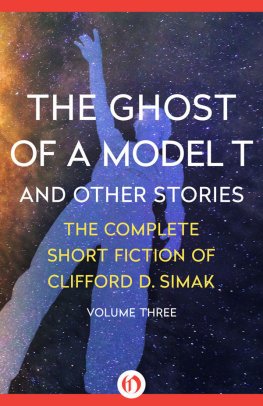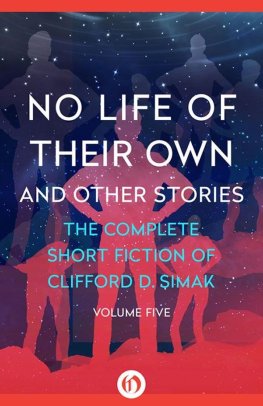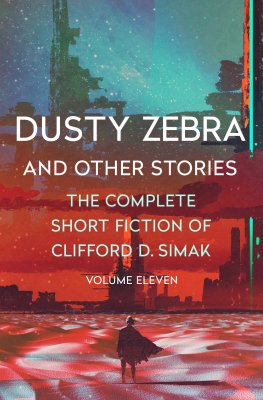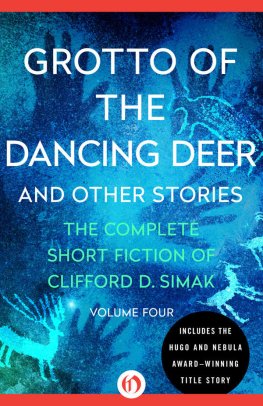The Big Front Yard
And Other Stories
The Complete Short Fiction of Clifford D. Simak, Volume Two
INTRODUCTION
CLIFFORD D. SIMAK: LEARNING ALL THE WORDS
Im looking for an alien, too. All of us, I think, are looking for your alien.
Clifford D. Simak, in So Bright the VisionClifford Donald Simak was born on August 3, 1904, on a ridge-top farm a few miles from the village of Millville in Grant County, Wisconsin a farm that belonged to his mothers parents. Cliffs grandfather, Edward Ned Wiseman, had been a member of the Second Wisconsin Volunteer Cavalry during the Civil War, taking part in the battles at Vicksburg and Gettysburg, and Cliff eventually became the proud possessor of Neds cavalry saber. Cliffs grandmother, Ellen Wiseman (ne Parker), seems to have had a special place in Cliffs heart, to judge by his clear use of her as his model for Ellen Forbes in Over the River and Through the Woods and his frequent uses of the names Parker and Ellen. (Cliff also named his daughter after her.)
The Wiseman farm was located atop the broad, tall bluffs on the south side of the Wisconsin River; from just a little farther along the ridge, one can easily see, off to the west, the confluence of the Mississippi and Wisconsin Rivers.
Cliffs parents were John Lewis Simak and Margaret Maggie Olivia Wiseman Simak. The two met when John, who had emigrated at age twelve from a small town near Prague in the area that would become the Czech Republic, came to work for Ned Wiseman. John would eventually clear some land for himself and build a log cabin just to the east of the Wiseman farm to be a home for the small family, which would later come to include a younger son, Carson.
As was not uncommon in the early part of the twentieth century, Cliff, having been born on a farm, never had a birth certificate. And he never missed it, he told me, except on one occasion, in the fifties, when his newspaper wanted to send him out of the country on assignment. He could not get a passport until he got his mother to attest that she had indeed given birth to him in the United States.
Cliff started his education at what was known as a country school, located a mile and a half from his home a distance he walked every day. It was one of those stereotypical old-time schools in which students of all ages sat in a single room, to be taught by the same teacher. When finished in the little school, Cliff went to high school a few miles to the south, in the town of Patch Grove. To get there he rode a horse an ornery gray mare, as he described her; he would say that although he loved her, and although he was sure she loved him, those feelings did not keep her from trying to kick him if she could.
The Wiseman and Simak farms were surrounded by woods where game abounded, cut by streams filled with fish, and the young Cliff Simak had the time of his life there. His boyhood, he would later say in an interview, was a sort of Tom Sawyer existence filled with hunting, fishing, and coon hunts, with horses and coon dogs when the farm chores were done for the day. Later he would comment that although it was the twentieth century, life in that rural setting was much like living in pioneer days: He swam in exactly the kind of creeks he would later describe in stories, he rose before dawn to help with the morning chores, he went barefoot in the summers
So how did he go on to become both a high-level newspaperman and a writer of award-winning fiction? It must have been built into him he remembered that by the age of five, he knew he wanted to be a newspaperman, having been told by his mother that newspapers print all the news from all over the world, and that they print the truth. His family had a tradition of gathering around while one of the parents read aloud from a book or newspaper.
Cliff would later tell me that by the age of eight, he had developed a goal to learn all the words there were, and it may be no coincidence that the Simak family stone in the little cemetery between Bridgeport and Patch Grove depicts an open book a Bible, no doubt, but still
Finishing second in his high school class, Cliff took a two-year teacher-training program and then taught school, over the course of the next three years, at a number of small towns in the area. Already an avid reader of Verne, Wells, and Burroughs, when he chanced on a copy of Amazing Stories in 1927, he became a regular reader of the science fiction magazines.
It was while teaching in Cassville, a very small town, that Cliff, attending the local movie theater, met a young woman from the nearby town of Glen Haven. She was Agnes Kuchenberg, known always as Kay, and she would later become his wife.
In 1927 or 1928 the Simak family removed to Madison, the state capital, where Cliff attended the University of Wisconsin (studying journalism), Carson went to high school, and John went into carpentry and masonry. The new occupation did not work out well for John, and when Kay and Cliff got married in April of 1929 and decided that he would drop out of the university to take a job working for a newspaper in Michigan, the rest of the family returned to the ridge.
Cliff started as a reporter at the Iron River Reporter. He quickly got a column of his own, called Driftwood, and within a few years had moved up to be editor. It was during this period that he began to try his hand at writing fiction.
He had already sold a number of stories when, in August 1932, the couple left Iron River for Spencer, Iowa, where Cliff became editor of the Spencer Reporter, and in July 1934 he moved on to North Dakota to become editor of the Dickinson Press.
At about that time, the Spencer newspaper was purchased by a Kansas City newspaper company, which persuaded Cliff to return to Spencer and convert the paper from a semiweekly to a daily. This went well, and the company made him a sort of troubleshooter, transferring him first to Excelsior Springs, Missouri, then to Worthington, Minnesota, and finally to Brainerd, Minnesota.
In 1939 Cliff took a job at the copy desk of theMinneapolis Star, and within a few years he became chief of the copy desk. Years later, he could still remember that the day he started to work for the Star was June 16. In 1949 he would become the papers news editor, and he stayed with the Star and its successors in various capacities until his retirement in 1976.
Its hard to know just when Cliff started writing stories himself. He kept a series of journals in which he recorded some of his submissions and sales and occasionally other events but he was sporadic, at best, in his data entry, and it appears that some of his journals did not survive. And although one of the surviving volumes contains a notation that a story entitled Mutiny on Mercury was submitted to a magazine at the end of 1930, theres no way to tell if that was his first attempt to write or submit fiction. The story was initially rejected, but Cliffs first sale came soon after, in 1931.
There was, however, one period during which Cliff left the Star. Early in World War II he accepted a job working for an intelligence agency of the US government. The nature of the job is not known, but it required Cliff and Kay to pack up their car and drive to Seattle a trip that was probably torturous, since there were no freeways in those days in fact, Kay recorded in her diary that it wasnt too long before they repacked the car, put it on a train to Seattle, and took another train themselves.
The stay in Seattle was short, though, and they returned to Minnesota before the end of 1942 the newspaper was eager to have Cliff back.
That began a period during which Cliff churned out short stories in a number of genres, all the while working full time at the paper. In 1947 the Simak family had a son, Richard Scott, and in 1951 a daughter, Shelley Ellen.








![Majkl Suenvik - Tales of Old Earth [A collection of short-stories]](/uploads/posts/book/894597/thumbs/majkl-suenvik-tales-of-old-earth-a-collection-of.jpg)



